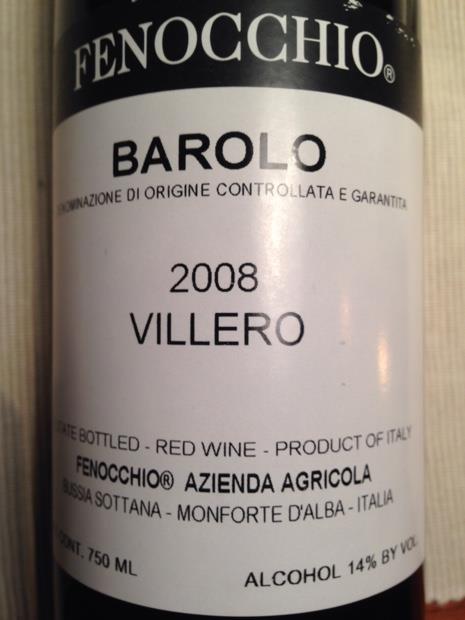
External search
Google (images)
Wine Advocate
Wine Spectator
Burghound
Wine-Searcher
Vintages
2020
2019
2018
2017
2016
2015
2014
2013
2012
2011
2010
2009
2008
2007
2006
2005
2004
2003
2002
2001
Show more
From this producer
Show all wines
All tasting notes
|
| Drinking Windows and Values |
| Drinking window: Drink between 2016 and 2024 (based on 5 user opinions) |
| Community Tasting History |
| Community Tasting Notes (average 88.8 pts. and median of 88 pts. in 6 notes) - hiding notes with no text | | | Tasted by CHINACAT on 5/27/2023 & rated 92 points: A pretty light ruby color, with a floral bouquet. Red cherries and rose petals, elegant and still fresh, with slightly firm finish. Still has time ahead of it. Very nice bottle. (191 views) | | | Tasted by torciaumana on 10/8/2022: regalato a JOerg (361 views) | | | Tasted by kevinacohn on 9/14/2017: My second bottle in as many months, this one confirmed my belief that now is the time to drink it. Not as austere as other traditionally made Barolo from 2006, this shows less secondary elements like rose petal, leather, and olive. The structure is starting to win out over the fruit, however, with the wine feeling a bit tired when I took the last sip four hours after decanting. To be sure, this is a good wine, just not up to Fenocchio's modern (2010 and later) level of quality. (1439 views) | | | Tasted by Barbera on 9/11/2016 & rated 86 points: Somewhat dusty with a hint to cork/defect. Some fruit still there, but in the background of the flawed taste. (1515 views) | | | Tasted by Zweder on 1/16/2011 & rated 88 points: Importer tasting (@ PA): Flowers in the bouquet. Red and black fruits e.g. plums. Firm tannin. Elegant style, but nevertheless this can last many years. (4096 views) |
| Giacomo Fenocchio Producer websiteNebbioloNebbiolo is a red grape indigenous to the Piedmont region of Italy in the Northwest. The grape can also be found in other parts of the world, though they are not as respected.
Nebbiolo is often considered the "king of red wines," as it is the grape of the famed wines of Barolo DOCG, Barbaresco DOCG, and Roero DOCG. It is known for high tannins and acidity, but with a distinct finesse. When grown on clay, Nebbiolo can be very powerful, tannic, and require long aging periods to reach its full potential. When grown on sand, the grape exhibits a more approachable body with more elegant fruit and less tannins, but still has high aging potential.
"Nebbiolo" is named for the Italian word, "nebbia", which means "fog", in Italian and rightfully so since there is generally a lot of fog in the foothills of Piedmont during harvest.
Nebbiolo is a late-ripening variety that does best in a continental climate that boasts moderate summers and long autumns. In Piedmont, Nebbiolo is normally harvested in October.
More links:
Varietal character (Appellation America) | Nebbiolo on CellarTrackerVilleroThe Villero vineyard (Castiglione Falletto) has a moderately clayey, calcareous and compact soil. The position is South-West and the height is 340 m.
N° of bottles produced approx.: 5,500
Vintage period and management: The manual harvest of the grapes takes place at the half of October.
Fermentation: With controlled temperature (about 28°C) for a period of 15 – 20 days.
Ageing and refining: The ageing takes place in French oak (mid size barrels of 30 Hl.), where the wine is allowed to mature for 2 years.
After the ageing, the wine is put in the bottles without any filtration. The refining is carried out in a place at constant temperature and right humidity, protected from sunlight and artificial light.
Tasting properties: A classic powerful and full-bodied wine from a historical vineyard of Castiglione Falletto. The colour is intense ruby red with a light presence of orange reflections. The smell is elegant, intense, pleasant , balanced and with a hint of withered roses, plums, minerals, tobacco, liquorice, smoke and leather. The taste is full bodied, balanced and velvety, with a huge structure and a very long finish.
Exact position on weinlagen.infoItaly Italian Wines (ItalianMade.com, The Italian Trade Commission) | Italian Wine Guide on the WineDoctorPiedmont Vignaioli Piemontesi (Italian only)
On weinlagen-infoLanghe Consorzio di Tutela Barolo Barbaresco Alba Langhe e Roero | Union of Producers of Albese Wines (Albeisa)BaroloRegional History:
The wines of Piedmont are noted as far back as Pliny's Natural History. Due to geographic and political isolation, Piedmont was without a natural port for most of its history, which made exportation treacherous and expensive. This left the Piedmontese with little incentive to expand production. Sixteenth-century records show a mere 14% of the Bassa Langa under vine -- most of that low-lying and farmed polyculturally. In the nineteenth century the Marchesa Falletti, a frenchwoman by birth, brought eonologist Louis Oudart from Champagne to create the first dry wines in Piemonte. Along with work in experimental vineyards at Castello Grinzane conducted by Camilo Cavour -- later Conte di Cavour, leader of the Risorgimento and first Prime Minister of Italy -- this was the birth of modern wine in the Piedmont. At the heart of the region and her reputation are Alba and the Langhe Hills. This series of weathered outcroppings south of the Tanaro River is of maritime origin and composed mainly of limestone, sand and clay, known as terra bianca. In these soils -located mainly around the towns of Barolo and Barbaresco -- the ancient allobrogica, now Nebbiolo, achieves its renowned fineness and power.
map of Barolo DOCG
An interesting thread on Traditional vs. Modern Barolo producers:
https://www.wineberserkers.com/forum/viewtopic.php?f=1&t=106291 |
|




